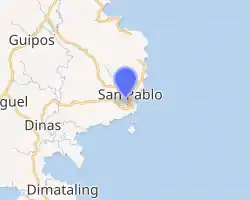San Pablo, Zamboanga del Sur
San Pablo, officially the Municipality of San Pablo (Cebuano: Lungsod sa San Pablo; Subanen: Benwa San Pablo; Chavacano: Municipalidad de San Pablo; Tagalog: Bayan ng San Pablo), is a 4th class municipality in the province of Zamboanga del Sur, Philippines. According to the 2015 census, it has a population of 26,106 people. [3]
San Pablo | |
|---|---|
| Municipality of San Pablo | |
 Map of Zamboanga del Sur with San Pablo highlighted | |
OpenStreetMap 
| |
.svg.png.webp) San Pablo Location within the Philippines | |
| Coordinates: 7°39′N 123°27′E | |
| Country | |
| Region | Zamboanga Peninsula (Region IX) |
| Province | Zamboanga del Sur |
| District | 2nd District |
| Founded | September 17, 1957 |
| Barangays | 28 (see Barangays) |
| Government | |
| • Type | Sangguniang Bayan |
| • Mayor | Danilo A. Taucan |
| • Vice Mayor | Roberto M. Aguilar |
| • Representative | Leonardo L. Babasa Jr. |
| • Electorate | 17,835 voters (2019) |
| Area | |
| • Total | 149.90 km2 (57.88 sq mi) |
| Elevation | 94 m (308 ft) |
| Population | |
| • Total | 26,106 |
| • Density | 170/km2 (450/sq mi) |
| • Households | 5,792 |
| Economy | |
| • Income class | 4th municipal income class |
| • Poverty incidence | 52.88% (2015)[4] |
| • Revenue | ₱85,585,509.08 (2016) |
| Time zone | UTC+8 (PST) |
| ZIP code | 7031 |
| PSGC | |
| IDD : area code | +63 (0)62 |
| Climate type | tropical climate |
| Native languages | Subanon Cebuano Chavacano Tagalog |
| Website | www |
Barangays
San Pablo is politically subdivided into 28 barangays.
- Bag-ong Misamis
- Bubual
- Buton
- Culasian
- Daplayan
- Kalilangan
- Kapamanok
- Kondum
- Lumbayao
- Mabuhay
- Marcos Village
- Miasin
- Molansong
- Pantad
- Pao
- Payag
- Poblacion (San Pablo)
- Pongapong
- Sacbulan
- Sagasan
- San Juan
- Senior
- Songgoy
- Tandubuay
- Taniapan
- Ticala Island
- Tubo-pait
- Villakapa
Climate
| Climate data for San Pablo, Zamboanga del Sur | |||||||||||||
|---|---|---|---|---|---|---|---|---|---|---|---|---|---|
| Month | Jan | Feb | Mar | Apr | May | Jun | Jul | Aug | Sep | Oct | Nov | Dec | Year |
| Average high °C (°F) | 31 (88) |
31 (88) |
32 (90) |
32 (90) |
31 (88) |
29 (84) |
29 (84) |
29 (84) |
29 (84) |
29 (84) |
30 (86) |
30 (86) |
30 (86) |
| Average low °C (°F) | 21 (70) |
21 (70) |
22 (72) |
23 (73) |
24 (75) |
24 (75) |
24 (75) |
24 (75) |
24 (75) |
24 (75) |
23 (73) |
22 (72) |
23 (73) |
| Average precipitation mm (inches) | 22 (0.9) |
18 (0.7) |
23 (0.9) |
24 (0.9) |
67 (2.6) |
120 (4.7) |
132 (5.2) |
156 (6.1) |
119 (4.7) |
124 (4.9) |
54 (2.1) |
24 (0.9) |
883 (34.6) |
| Average rainy days | 9.4 | 9.1 | 11.5 | 11.9 | 20.1 | 22.5 | 22.4 | 23.2 | 21.5 | 22.2 | 15.7 | 11.5 | 201 |
| Source: Meteoblue [5] | |||||||||||||
Demographics
| Year | Pop. | ±% p.a. |
|---|---|---|
| 1960 | 10,364 | — |
| 1970 | 17,919 | +5.62% |
| 1975 | 16,171 | −2.04% |
| 1980 | 19,421 | +3.73% |
| 1990 | 21,230 | +0.89% |
| 1995 | 23,147 | +1.63% |
| 2000 | 23,450 | +0.28% |
| 2007 | 25,575 | +1.20% |
| 2010 | 26,500 | +1.30% |
| 2015 | 26,106 | −0.28% |
| Source: Philippine Statistics Authority [3] [6] [7][8] | ||
References
- Municipality of San Pablo | (DILG)
- "Province: Zamboanga del Sur". PSGC Interactive. Quezon City, Philippines: Philippine Statistics Authority. Retrieved 12 November 2016.
- Census of Population (2015). "Region IX (Zamboanga Peninsula)". Total Population by Province, City, Municipality and Barangay. PSA. Retrieved 20 June 2016.
- "PSA releases the 2015 Municipal and City Level Poverty Estimates". Quezon City, Philippines. Retrieved 12 October 2019.
- "San Pablo: Average Temperatures and Rainfall". Meteoblue. Retrieved 1 May 2020.
- Census of Population and Housing (2010). "Region IX (Zamboanga Peninsula)". Total Population by Province, City, Municipality and Barangay. NSO. Retrieved 29 June 2016.
- Censuses of Population (1903–2007). "Region IX (Zamboanga Peninsula)". Table 1. Population Enumerated in Various Censuses by Province/Highly Urbanized City: 1903 to 2007. NSO.
- "Province of Zamboanga del Sur". Municipality Population Data. Local Water Utilities Administration Research Division. Retrieved 17 December 2016.
External links
- San Pablo Profile at PhilAtlas.com
- Philippine Standard Geographic Code
- Philippine Census Information
This article is issued from Wikipedia. The text is licensed under Creative Commons - Attribution - Sharealike. Additional terms may apply for the media files.